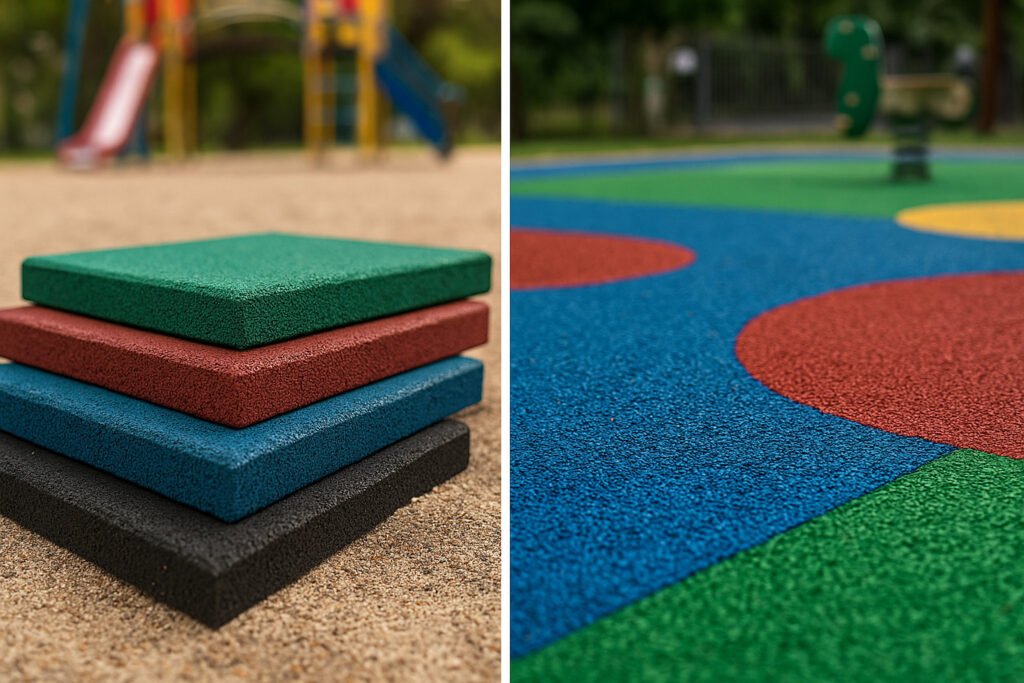Rubber Tiles vs. EPDM Granules for Outdoor Playgrounds – Which Should You Choose?
Choosing the wrong playground surface can lead to accidents, expensive maintenance, or unhappy parents.
Rubber tiles are easy to install and maintain, while EPDM granules offer more color options and better design flexibility. Each option fits different project needs.

If you’re building or renovating an outdoor playground, you’ve probably asked: Should I use rubber tiles or pour-in-place EPDM granules? Let’s compare these two options in a clear, practical way.
What are the main differences in structure and installation?
Rubber tiles and EPDM granules are made from similar materials—but the way they are installed is completely different.
Rubber tiles are pre-made mats placed on the ground. EPDM granules are poured and shaped directly on site.
| Feature | Rubber Tiles | EPDM Granules (Wetpour) |
|---|---|---|
| Structure | Factory-molded tile | Poured in place with PU binder |
| Installation | Modular, fast installation | Requires skilled labor onsite |
| Surface Appearance | Straight edges, limited patterns | Seamless, can include patterns |
| Repair | Easy to replace single tile | Must cut and re-pour damaged area |
Learn more about our outdoor rubber floor options, including interlocking tiles and molded solutions.
Which is safer for children?
Both options are safe—but they behave differently in high-fall zones.
EPDM granules can be poured thicker in high-risk areas, while rubber tiles are limited to pre-made thicknesses.
Impact absorption and safety certifications
| Surface Type | Typical Thickness | HIC Rating | EN1177 Certified? |
|---|---|---|---|
| Rubber Tile | 25–50mm | Up to 1.5m | Yes |
| EPDM Wetpour | 10–15mm+ (custom) | Up to 2.5m | Yes |
More about EN1177 impact standards: TÜV – EN1177 Explained
Our products are all EN1177 and CE certified. See our project cases for real-world installations.
Which looks better?
If you want logos, bright colors, or animal patterns—EPDM is the better option.
Rubber tiles come in basic colors like red, green, and black. EPDM lets you design full scenes, games, and custom branding.
But don’t ignore maintenance: EPDM might fade over time if not maintained, while rubber tiles are easier to clean.
We offer colorful options across our EPDM granules and puzzle rubber tile product lines.
What about long-term maintenance?
Maintenance is where tiles often win.
If a rubber tile breaks, just replace that tile. If EPDM cracks, you need to cut and re-pour that section with color matching.
| Task | Rubber Tile | EPDM Wetpour |
|---|---|---|
| Replace damaged area | Easy | Difficult |
| Cleaning | Simple sweep or wash | Needs care for color areas |
| Weather resistance | Good | Very good |
Browse our tiny granule rubber tile and laminated gym rubber tile for easier upkeep options.
Which costs more?
Rubber tiles have a lower starting cost and need less labor. EPDM is more expensive upfront, but can add visual value.
| Cost Type | Rubber Tiles | EPDM Granules |
|---|---|---|
| Material | $$ | $$$ |
| Labor | Low | High |
| Installation Time | Short | Long |
| Design Flexibility | Low | High |
For low-traffic zones or office walkways, consider gym rubber rolls as a cost-effective alternative.
What should you choose for your project?
Every playground is different. Here’s a quick guide:
| Project Type | Best Surface |
|---|---|
| Small Daycare | Rubber Tiles (25–30mm) |
| Kindergarten | Rubber Tiles or EPDM |
| Public Park | EPDM Wetpour (thicker) |
| Custom Design Needed | EPDM with logo/pattern |
| Tight Budget | Rubber Tiles |
Need help deciding thickness? Read our Playground Flooring Thickness Guide
Conclusion
Both rubber tiles and EPDM granules are great options. It depends on your safety needs, design goals, and budget.
Related Reads:
- Playground Flooring Thickness Guide
- EPDM vs. PU for Outdoor Flooring
- Rubber Flooring Installation Guide
- Outdoor Rubber Floor Solutions
Looking for safe, certified, and colorful outdoor flooring? Visit Lanhefloor or contact us to request a quote or product sample.
